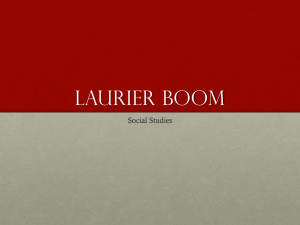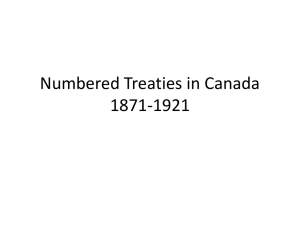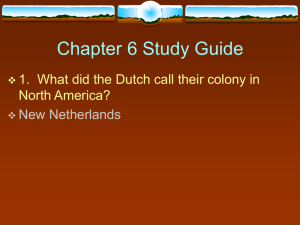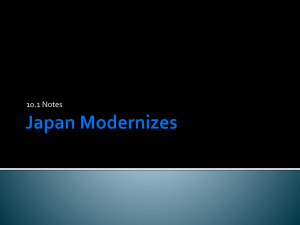Chapter 10
advertisement
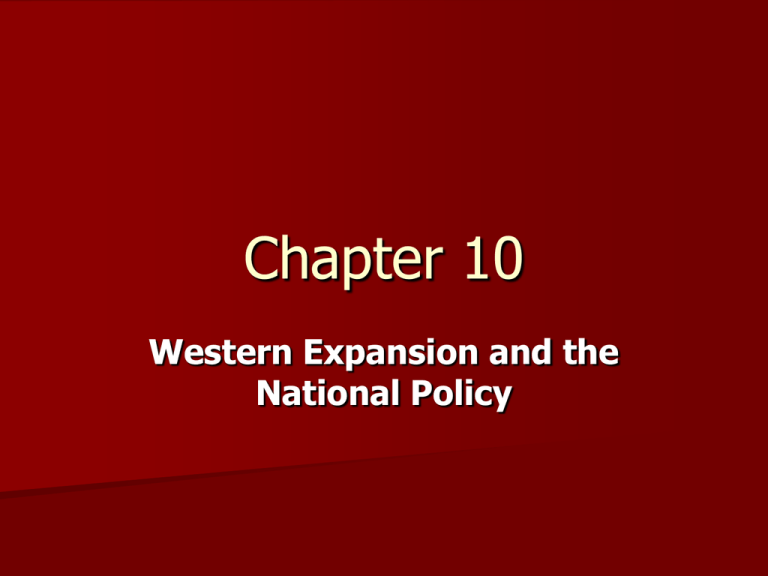
Chapter 10 Western Expansion and the National Policy Focus Questions What ideas of citizenship shaped Canada’s western expansion? How did immigration shape the demography and economy of western Canada? What challenges did the immigration pose for peoples already living in western Canada? Getting the West Ready for Settlement In 1871, BC joined confederation and Canada’s government promised a link to eastern Canada via the railway. The Canadian federal government was required to negotiate treaties with the First Nations living in the west because of the Royal Proclamation of 1763 and because the United States had difficulty moving west. Canada & the U.S, took two different perspectives. The United States fought with First Nations. Canada took the peaceful way or were the treaties just as unjust? The Numbered Treaties The treaties were numbered in chronological order beginning in 1871 and ending in 1921. Treaties Canadian Government Perspective Treaties would assimilate First Nations . Government believed they now “owned” the land. Canadian government put treaties in writing—if it “wasn’t in writing, it wasn’t in the treaty.” First Nations Perspective Treaties would help them adapt and ensure their culture survived. First Nations people didn’t have the same understanding of the word “own”. They believed they were sharing the land. First Nations practice was to do everything orally. Treaties Treaties promised the First Nations Education, health care, reserves, rights to hunt and fish, farming assistance and payments Residential Schools were a method to force assimilation upon the First Nations by separating parents and children, disrupting their connections to their language, culture and traditions. Treaties By 1885 the railway was complete and the treaties were being signed The west was now ready for change and immigration. Western Canada’s population began to soar while buffalo began to decline. Northwest Mounted Police Founded in 1873 following the massacre of Nakoda First Nations by Canadian & American traders. The traders set up Fort Whoop and began selling alcohol and guns for buffalo and furs. First regiment of NWMP was in Dufferin, Manitoba in 1874. Northwest Mounted Police First headquarters was in Fort Macleod. The NWMP quickly developed a trust with the First Nations that allowed the railway and settlers to come west. The National Policy In the“Pacific Scandal” of 1873, John A. Macdonald was accused of accepting bribes in order to reward the railway contract to CP Railway. They supported Macdonald and the Conservative Party. After Macdonald lost the 1873 election, he would come back to power in 1878 with The National Policy as his election platform. The National Policy Elements of the National Policy: – Promote Canadian Identity – Proposed that people buy Canadian products regardless of price. – Proposed a tariff on American goods sold in Canada. – Fulfill promise of railway to BC and help take settlers west and their crops east. – Settle the West by giving immigrants free land. This would promote settlement. – The west would be the agriculture capital of Canada. Chinese Railway Workers Many of the Canadian Pacific Railway workers were from China because they provided a source of cheap labor. After the railway was built, they would move to lumber and cannery industries. However, the Chinese faced extreme discrimination wherever they went. They were considered to be “non-citizens” of Canada. Chinese Railway Workers Eventually, Canada would attempt to restrict Chinese immigration by passing laws that required the Chinese to pay $50 to enter Canada. This required payment to enter Canada was called the “Head Tax.” Although it was a lot of money at the time, many Chinese paid it and continued to come to Canada. Canada would continue to increase the “Head Tax” as immigration from China continued. The railway would finally be completed in 1885 and connected Canada from sea to sea. Impacts of Immigration on Western Canada Impacts of Immigration on Western Canada In 1890 only 2 % of Canada’s population lived in the west. To Wilfred Laurier, (Prime Minister, July 1986), the growth of the west became an important priority to make Canada strong and protect against US expansion. Clifford Sifton Clifford Sifton (Minister of the Interior) began an advertising campaign to attract immigrants from the United States and Britain but excluded French speaking countries such as France, Switzerland or Belgium. Sifton placed posters in train stations, fairs and offices to show Canada’s incredible farmland for free. Immigrants Come to Western Canada Sifton believed “British is best” and especially wanted farmers to come from Britain. However, the immigrants to Western Canada would actually come from many different ethnic groups. Many immigrants came from Eastern Europe (Ukraine, Russia, Poland). Many people already living in Western Canada were uneasy about the massive immigration. French Speaking Settlers – French leaders wanted Canadiens and Catholics to be able to settle in the west. – Missionaries were set up to help recruit French people to come to western Canada. French Speaking Settlers – French Speaking settlers worked to establish communities such as Beaumont and Morinville. – Catholic schools were established for French speaking people. – These schools offered higher education (ie: university level schooling) in French. – Francophones were able to enter politics with the creation of Alberta & Saskatchewan in 1905. French Speaking Settlers – French speakers founded newspapers that reported all levels of news. – Catholic hospitals were founded including the Grey Nuns in Edmonton (formerly the Edmonton General) Eastern Europeans Contributed to the economic and industrial growth to Canada’s west. They provided new markets for manufactured products. They helped to increase agricultural production Ukrainian Settlers Ukrainian settlers moved west because of the fertile soil. Population in West: 1896- 1 000 1914- 200 000 Russian & Polish Settlers Russian and Polish immigrants settled predominately in cities. They started factories mills and bee colonies. The coal mining industry also experienced growth. Because of the low wages many would join political groups or create unions for better working conditions and wages. Alberta & Saskatchewan In 1875 the federal government controlled the land in the western territories. An elected representation could only be based upon populations of over 1,000 people. In 1891 this elected assembly took over. The group could control roads and schools but could not tax to make money for other projects. Only provinces had the power to ask for taxes from their inhabitants. Alberta & Saskatchewan Frederick Haultain, the Premier of the North-West Territories campaigned to have their own provincial rights. Wilfred Laurier believed the area was too large to be one province, so Canada’s government split the land into two provinces: Alberta & Saskatchewan. These provinces were established in 1905.
